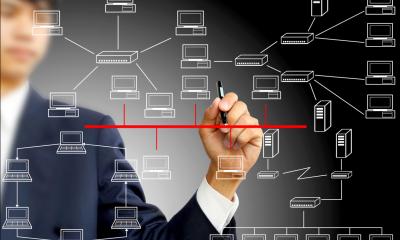
Giving people in your business remote access to their email, files and other systems - no matter where they are - allows them to work more efficiently and flexibly. Many more businesses are embracing homeworking. But, before giving remote access to your software and systems, it’s crucial that you develop a strategy that protects your employees, your business and - crucially - your customers. Here's our guide to creating a safe and secure remote working solution
What is remote access?
Remote access means allowing people to access your business computer systems, software and communications technologies, even when they're not directly connected to your company network. For instance:
- Enabling staff to log in to your customer database from home.
- Setting up a project workspace where clients can share and view files.
- Allowing employees to send and receive email from any computer.
Remote access makes it easier for people to work effectively when away from your premises. By allowing employees to remotely access your primary systems, staff working from home are less likely to interrupt people in the office to ask them to send files over. It can improve productivity, with staff able to work when they want. They can be more responsive to organisational need – as well as avoiding the dreaded commute!
However, remote working is not without its downsides. Communication, project management and teamworking can all be more challenging when your staff are working from different locations. Thankfully there are a range of apps that can help overcome most of these challenges such as monday.com, HubStaff and Slack.
Before investing in remote working technologies, decide what elements of your system you want to give your staff access too. The key principle underpinning your approach to remote working should be about providing access to the systems your staff need to perform their roles, and no more.
Win and keep customers
Track all customer enquiries and make sales simpler with CRM software. Find your perfect fit with these tools from our Donut partners.
Security first
Remote working is safer than it’s ever been, but there is still a risk. GDPR legislation makes it clear that personally identifiable information should be stored securely, with access to it limited. All computers, laptops, tablets and mobiles that can access such systems must be protected with anti-virus software and firewalls.
To access systems remotely, your staff will be responsible for setting up passwords. They should receive guidance on password etiquette, including never using the same password more than once and changing them regularly. While you can never remove the risk, you can minimise it by ensuring staff follow common sense advice on creating hard-to-hack passwords.
And remember: remote access isn't limited to laptops. These days, mobile phones and tablet computers are so powerful you can run your entire business from them. If your staff are using their own devices to access your systems, they should be as well protected as your own equipment. Any weakness can be exploited by a hacker, so all staff must be made aware of their responsibilities in keeping things safe.
Remote access without a server
Traditionally, you needed a network server to control permission levels and effectively allow remote access in your business.
However, these days cloud computing services provide one of the easiest routes to remote access.
For example, you could use an online collaboration system to share files. And an email service - such as that included with Microsoft 365 - allows your staff to access their email from any location.
Online services are becoming increasingly popular, particularly for smaller businesses that are unable to justify investing in their own server. Cloud software providers have invested in security, with many offering two-factor authentication to ensure it’s only the people you want to access your files can do so.
Tools like Dropbox, Google Drive and Box are excellent ways to store files online, where authorised people in your business can view them. As an administrator, you can view who has viewed files and when, providing an audit trail in the unfortunate event that you need one.
Cloud computing services offer a secure and low-cost way to give staff access to your files and software remotely. If your business ranks mobile working as a high priority, it's worth consulting your IT supplier to understand how cloud services can help.
If using various cloud software providers seems complicated, you may prefer to use remote desktop connection software. This works like a remote control for your main computer, so you can log in to it over the internet and access your usual programs, files and settings, providing a more familiar interface for your staff to use.
Some versions of Microsoft Windows come with Windows Remote Desktop as standard. The latest version, Windows 11, allows you to connect to your main office computer from a tablet computer, so you can safely use all your usual software.
Remote access to email and files
The simplest types of remote access open up specific, isolated parts of your systems:
- Email. Implementing remote access to email is usually straightforward and most people have access to their emails on their mobile devices. Where you don't want potentially sensitive emails on an employee's mobile phone, most email systems include a web interface so you can check email by visiting a specific website address (a bit like using Outlook or Gmail).
- External file sharing. If you need to offer access to files stored on your systems, you can open up certain areas so anyone can log in and download files. This is also called an extranet.
If your business is largely based in a single location and your staff tend not to work while they're out and about, these options are suitable for occasional use.
One risk with offering remote access is the tendency for employees to save files to their own computers and laptops. This can cause issues with version control, but more importantly, can risk data being stored in violation of rules
Before giving staff access to email and file-sharing systems, provide guidance on the importance of maintaining the integrity of your systems. You can provide information on how and where to save documents and describe the potential pitfalls of local saving and storage.
A remote connection to all your systems
If you have a server, you can provide remote access to company systems through a virtual private network (VPN). A VPN creates a secure link between your network and your employee's computer across the internet.
All of the information sent between the two is encrypted, so nobody can intercept it. You can access all the resources on your company network just as if you were in the office.
Setting up a secure VPN can be a complicated task that requires extra hardware and software. Because a VPN allows wide access to your company systems, you need to take adequate security precautions too.
Building a VPN is usually a job for IT experts who can provide advice and guidance on how it can be configured and managed. While it’s a serious investment in IT, a VPN from a trusted provider will offer the gold-standard of remote working and could prove worth it for those organisations who need the highest levels of security for their data and information.



